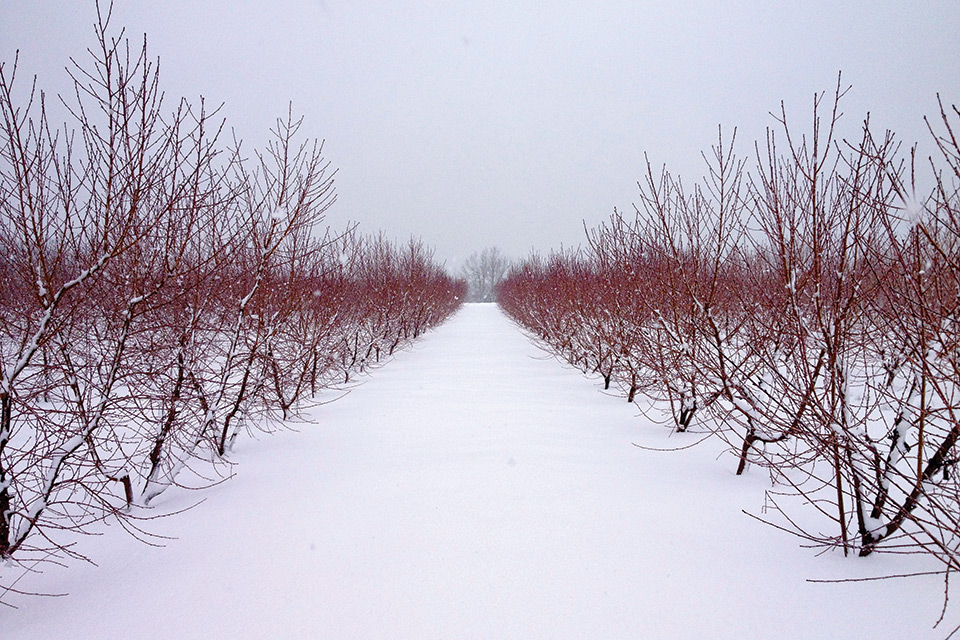Ways Pruning Affects Tree Fruit Cold Hardiness

Pruning just before a cold snap increases susceptibility to injury. (Photo: Christina Herrick)
Editor’s note: This article was originally published on Penn State University’s Extension website. You can find the complete article online.
After fruit trees go dormant, there is a chilling requirement that must be met before new buds will start to grow. This chilling requirement is met when the trees are exposed to temperatures above 32°F, up to about 65°F. The temperature providing maximum chilling is about 47⁰F, and temperatures that are higher or lower contribute less to the chilling requirement.
How much chilling is required depends upon the species. For peaches, it may be 800 to 1,200 chilling hours. Low-chill varieties may require less than 200 chill hours. Most varieties of apples take more than 1,200 chill hours. Mixing periods of chilling with periods when temperatures are warm seems to lengthen the chilling requirement. This probably explains in part why we can call these trees well-adapted to our fluctuating winter weather.
It is best to delay dormant pruning until as late in the winter as possible in order to complete the job by bloom. . Keep a watchful eye on the long-range forecast and suspend pruning when a severe drop in temperature is forecast. Recently pruned trees can be damaged when temperatures suddenly drop 50°F or 60°F to 0°F or below. This increased sensitivity is greatest within 48 hours after pruning and gradually declines over a two-week period.
Developing Freeze Tolerance
Cold acclimation is the process leading to the development of freezing tolerance in plants. Fruit trees, like other woody plants, gradually acclimate to low temperatures in the autumn in three stages. Short photoperiods, sensed by the leaves, trigger the onset of the first stage of acclimation and plants will develop 10 to 15 degrees of cold tolerance as the days become shorter. Warm temperatures (60˚F to 70˚F) combined with short days promote maximum hardening due to increased metabolic activity.
Following a period of warm temperature preconditioning, cold acclimation is continued by a period of cool nonfreezing temperatures (60˚F days and 40˚F nights). A second stage of acclimation occurs upon exposure to subfreezing temperatures (23˚F to 27˚F). This increase in hardiness is very rapid and trees may be as much as 10˚ hardier the day after a frost than they were the previous day. The final stage of acclimation, resulting in maximum cold tolerance, is initiated by exposure to temperatures approaching 0˚F.
During the winter, trees remain hardy as long as the temperatures remain fairly cold. However, trees de-acclimate in response to warm temperatures. Trees can also re-acclimate when warm temperatures are followed by normally cold winter temperatures. A mid-winter severe cold snap may not injure plants unless it is immediately preceded by unseasonably mild conditions. Later in the winter, when the chilling requirement has been satisfied, trees begin to lose the ability to re-acclimate to hardiness levels obtained earlier in the winter, and may only partially re-acclimate.
How Pruning Influences Cold Hardiness
Although there is quite a bit of anecdotal evidence indicating that pruning early in the winter can reduce the cold hardiness of woody plants, there have been few controlled experiments to determine how hardiness is affected by time of pruning, how long the pruning effect may last, and if pruning severity is involved. Some of the best research on time of pruning of peach trees was done in South Carolina and Georgia in an attempt to identify practices that contributed to peach tree short life (PTSL).
PTSL is a complex disorder of peach trees in the southeastern U.S. causing excessive mortality of trees less than 10 years old. Conditions contributing to PTSL seem to include nematodes and other soil pathogens, rootstock selection, and fall pruning. A series of experiments conducted during the 1960s and 1970s showed that fall-pruning of trees on sites with a history of PTSL were susceptible to late winter cold injury that killed the trees. Trees on sites with no history of PTSL were less affected by fall pruning. Pruning studies with other woody species, such as grapes, crape myrtle, and cypress showed that pruning in the fall reduced the cold hardiness of the plants during the winter. A couple of interesting facts have emerged from these studies.
Pruning in November tends to reduce the cold hardiness of woody plants until late February, so the effects of pruning are fairly long-lasting. Pruning experiments with peach show that fall-pruned trees had higher levels of the growth regulator indoleacetic acid (IAA). This is the naturally occurring auxin that is mimicked by the synthetic auxins that are used commercially, including NAA, 2,4,5-TP, and 2,4-D. Cambial activity (the tissue in the bark responsible for cell division contributing to trunk and stem radial growth) seems to be stimulated by the increased IAA levels following pruning. Peach trees pruned in November exhibited enhanced cambial activity in February.
How Summer Pruning Can Influence Cold Hardiness
More recently, summer pruning of peach trees in August was shown to delay leaf abscission and cold acclimation, so flower buds on summer pruned trees were less cold hardy than non-pruned trees in the early winter, but not in the mid-winter. A few years ago, peach trees that were pruned in the pink stage had more injury than non-pruned trees when a frost occurred two days after trees had been pruned. Based on observing peach trees that were approaching bloom, in some years pruned trees begin to bloom and leaf out a little earlier than trees that were not yet pruned.
Based on everything that has been published, we can conclude that woody plants do not attain maximum cold hardiness when they are pruned in the fall. Trees are affected more by heavy pruning than light pruning. There is still much that we don’t know about the practical implications of how pruning affects cold hardiness. We especially don’t know how rapidly pruning causes de-acclimation, or if de-acclimation is similar in the early-, mid-, and late-winter, and we don’t know how long the trees remain de-acclimated. We also don’t know if the de-acclimation following pruning is affected by mid-winter warm spells, which we seem to be experiencing more frequently.









